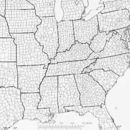Brief Summary
(
Inglês
)
fornecido por EOL authors
Abies fraseri, Fraser fir, also called southern balsam fir and she-balsam, is an evergreen, coniferous, small- to medium-sized tree in the Pinaceae (pine) family. It is the only fir endemic to the southern Appalachian Mountains, where it is restricted to high elevations in southwestern Virginia, western North Carolina, and eastern Tennessee. Because of the high elevation at which Fraser fir grows, its primary value is for watershed protection and scenic attraction. Extensive stands of Fraser fir have been damaged by the balsam woolly adelgid (Adelges piceae), which was first was discovered in North Carolina in 1957 and has since spread to all areas of Fraser fir. Mortality progressed rapidly from 11,000 trees in 1958 to about 1.75 million by 1970. Fir mortality has been extensive in all areas except Mount Rogers in Virginia. Adelgids attack branches, twigs, nodes, and bud bases of fir, but stem attack is the predominant form of infestation. Death usually follows 2 to 5 years after infestation of the bole because of direct translocation impairment. Trees weakened by adelgids are often attacked and further damaged by bark beetles, wood wasps, and other wood-boring insects, which also may introduce fungal pathogens. Incidence of root rot caused by Armillaria mellea was shown to increase with increasing severity of adelgid damage. Damaged and weakened trees are also more susceptible to windthrow and top breakage. Mortality from adelgids and associated damage agents has been estimated at 80% across the tree’s range. Due to this precipitous decline, Fraser fir now appear on the Federal Endangered Species Act list of species of concern, is listed as vulnerable on IUCN (International Union for the Conservation of Nature) Red List, is categorized as threatened in Tennessee, and is on the watch list/declining in North Carolina. It is not clear whether the species can recover. Although openings created by adelgid kill usually contain numerous fir seedlings, it is not yet known whether these, too, will be attacked when they reach maturity. Unless new methods of adelgid control are found, the status of Fraser fir in natural stands is extremely uncertain. The remaining stands of Fraser fir have very limited commercial value. However, their location in the cool climate of the loftiest peaks and ridges makes them extremely valuable for watershed protection, as they hold the shallow soil to the steep wet slopes. They are also a unique scenic attraction in a region of growing recreational appeal. Growing and harvesting this species for Christmas trees and boughs is a multimillion-dollar business in the southern Appalachians. Because of its thick green foliage, beautiful shape, fragrance, and needles that are retained unusually well, Fraser fir is unequaled as a Christmas tree, and has frequently been used as the official White House Christmas tree for the President of the U.S. It is also used widely as an ornamental yard tree. Fraser fir seeds and terminal buds are eaten extensively by the red squirrel and other mammals. Various songbird species eat the seeds. (Beck 1990)
- citação bibliográfica
- Beck, D.E. <i>Abies fraseri</i> (Pursh) Poir. In Burns, Russell M., and Barbara H. Honkala, tech. coords. 1990. Silvics of North America: 1. Conifers; Agriculture Handbook 654. U.S. Department of Agriculture, Forest Service, Washington, DC.
- autor
- Jacqueline Courteau (Jacqueline Courteau)

